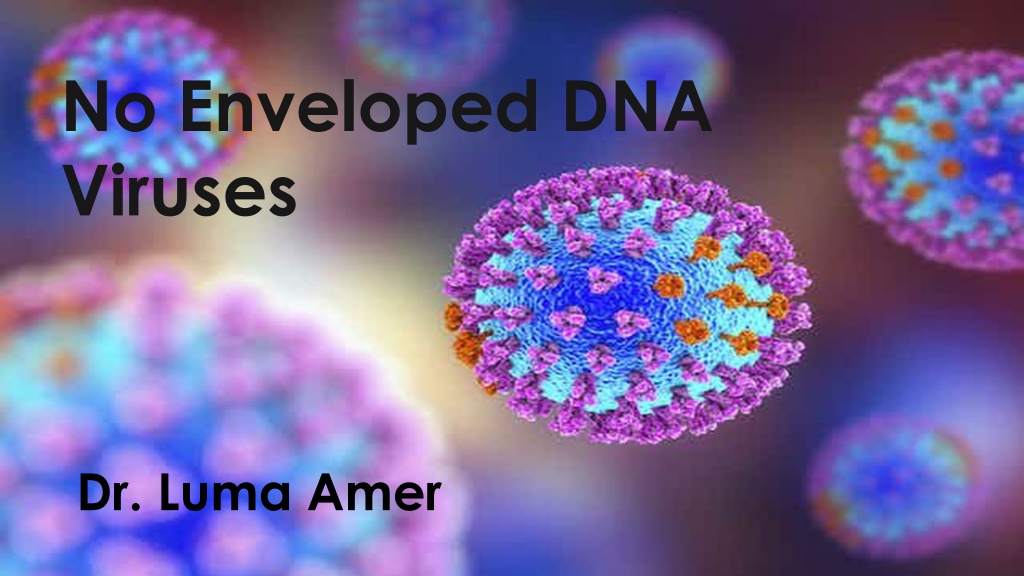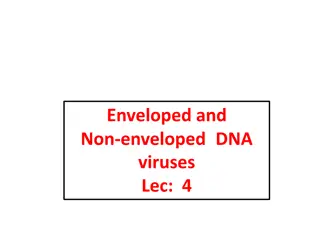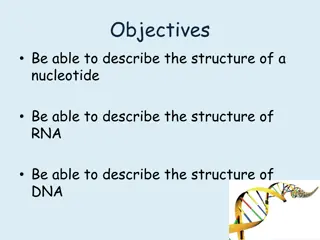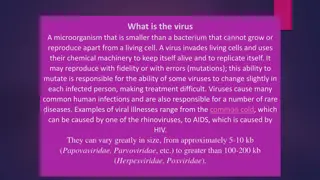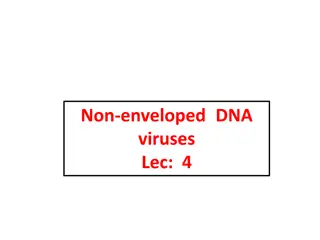Understanding No Enveloped DNA Viruses: Papillomaviruses and Polyomaviruses
Explore the characteristics and implications of no enveloped DNA viruses, such as Papillomaviruses causing common warts and Polyomaviruses inducing tumors in animals. Learn about their genetic properties, potential for carcinogenesis, and infections in different host systems.
Download Presentation

Please find below an Image/Link to download the presentation.
The content on the website is provided AS IS for your information and personal use only. It may not be sold, licensed, or shared on other websites without obtaining consent from the author. Download presentation by click this link. If you encounter any issues during the download, it is possible that the publisher has removed the file from their server.
E N D
Presentation Transcript
No Enveloped DNA Viruses Dr. Luma Amer
Papillomaviruses Common seed warts painless, elevated, rough growth; on fingers, etc. Plantar warts deep, painful; on soles of feet Genital warts -morphology ranges from tiny, flat, like masses .
No enveloped DNA Viruses Adenoviruses Papillomaviruses Polyomaviruses Parvoviruses
Polyoimaviruses Induce tumors in experimental animals JC(john Cunningham) Common infection of childhood; persists in kidney epithelium, lymphocytes, and bone marrow; produces PML(progressive multifocal leukoencephalopathy) in immuno-compromised hosts BK viruses most important human polyomas, Common infection of childhood; persists in kidney epithelium and possibly lymphocytes BK infection in renal transplants causes complications in urinary function Common throughout the world Majority of infections are asymptomatic or mild Progressive multifocal leukoencephalopathy (PML) is an uncommon fatal infection by JC
Important Properties Papillomaviruses : Nonenveloped viruses . Double-stranded circular DNA . An icosahedral nucleocapsid . The HPV genome has seven early genes (E1 E7) and two late genes (L1 and L2). The early genes encode proteins involved in the synthesis of viral mRNA and in the replication of the progeny DNA genomes, and the late genes encode the structural proteins of the progeny virions
Two of the early genes, E6 and E7, are implicated in carcinogenesis. They encode proteins that inactivate proteins encoded by tumor suppressor genes in human cells (e.g., the p53 gene and the retinoblastoma [RB] gene, respectively). Inactivation of the p53 and RB proteins is an important step in the process by which a normal cell becomes a cancer cell. There are at least 100 types of papillomaviruses, classified primarily on the basis of DNA restriction fragment analysis .For example, skin warts are caused primarily by HPV-1 through HPV-4, whereas genital warts are usually caused by HPV-6 and HPV-11. Approximately 30 types of HPV infect the genital tract.
Summary of Replicative Cycle After attachment and uncoating, the genome DNA moves to the nucleus. Messenger RNA is synthesized by host cell RNA polymerase with early viral protein E2 acting as a transcriptional activator. Early viral protein E1 acts as a helicase that separates the DNA strands of the incoming viral genome. This allows the host cell DNA polymerase to synthesize the progeny DNA genomes. The initial progeny genomes are maintained as episomes in the nucleus. Most of the synthesis of progeny viral DNA occurs in conjunction with cellular DNA synthesis during S phase.
In human tissues, infectious virus particles are found in the terminally differentiated squamous cells rather than in the basal cells . Note that HPV initially infects the cells of the basal layer in the skin, but no virus is produced by the basal cells.
Papilloma virus and malignant: In malignant cells : Viral DNA is integrated into host cell DNA in the vicinity of cellular proto-oncogenes. E6 and E7 are overexpressed . However, in latently infected, nonmalignant cells, the viral DNA is episomal, and E6 and E7 are not overexpressed. This difference occurs because another early gene, E2, controls E6 and E7 expression. The E2 gene is functional when the viral DNA is episomal but is inactivated when it is integrated.
Transmission & Epidemiology: Papillomaviruses are transmitted primarily by skin-to-skin contact, including genital contact. HPV transmitted from an infected mother to the neonate during childbirth causes warts in the mouth and in the respiratory tract, especially on the larynx, of the infant. Many species of animals are infected with their own types of papillomaviruses, but these viruses are not an important source of human infection.
Pathogenesis & Immunity Most warts are benign and do not progress to malignancy. HPV infection is associated with carcinoma of the uterine cervix and penis. The proteins encoded by viral genes E6 and E7 interfere with the growth-inhibitory activity of the proteins encoded by the p53 and RB tumor suppressor genes and thereby contribute to oncogenesis by these viruses. The E6 and E7 proteins of HPV-16 bind more strongly to p53 and RB proteins than the E6 and E7 proteins of HPV types not implicated in carcinomas a finding that explains why HPV-16 causes carcinomas more frequently than the other types of HPV.
Laboratory Diagnosis : Infections are usually diagnosed clinically. The presence of koilocytes in the lesions indicates HPV infection. PCR-based test can be used to detect the presence of the DNA of 14 high- risk genotypes, including HPV-16 and HPV-18. Diagnostic tests based on detection of antibodies in a patient s serum or on isolation of the virus from a patient s tissue are not used.
